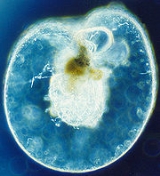
Noctilucales
Encyclopedia
The Noctilucales are a peculiar order of marine dinoflagellate
s.
does not show a dinokaryotic organization; also they show gametic meiosis.
These cells are very large, from 1 to 2 millimetres in diameter, and are filled with large buoyant vacuole
s. Some may contain symbiotic green algae, but there are no chloroplast
s. Instead, they feed on other plankton
, and there is usually a special tentacle involved in ingestion.
Noctilucales reproduce mainly by fission, but sexual reproduction
also occurs. Each cell produces numerous gametes, which resemble more typical athecate dinoflagellates and have the dinokaryotic nuclei. Evidence suggests that they diverged from most other dinoflagellates early on, and they are generally placed in their own class.
, also called N. miliaris. It can be bioluminescent
when disturbed, as are various other dinoflagellates, and large blooms can sometimes be seen as flickering lights on the ocean.
Another example is Spatulodinium pseudonoctiluca.
Dinoflagellate
The dinoflagellates are a large group of flagellate protists. Most are marine plankton, but they are common in fresh water habitats as well. Their populations are distributed depending on temperature, salinity, or depth...
s.
Characteristics
They differ from most others in that the mature cell is diploid and its nucleusCell nucleus
In cell biology, the nucleus is a membrane-enclosed organelle found in eukaryotic cells. It contains most of the cell's genetic material, organized as multiple long linear DNA molecules in complex with a large variety of proteins, such as histones, to form chromosomes. The genes within these...
does not show a dinokaryotic organization; also they show gametic meiosis.
These cells are very large, from 1 to 2 millimetres in diameter, and are filled with large buoyant vacuole
Vacuole
A vacuole is a membrane-bound organelle which is present in all plant and fungal cells and some protist, animal and bacterial cells. Vacuoles are essentially enclosed compartments which are filled with water containing inorganic and organic molecules including enzymes in solution, though in certain...
s. Some may contain symbiotic green algae, but there are no chloroplast
Chloroplast
Chloroplasts are organelles found in plant cells and other eukaryotic organisms that conduct photosynthesis. Chloroplasts capture light energy to conserve free energy in the form of ATP and reduce NADP to NADPH through a complex set of processes called photosynthesis.Chloroplasts are green...
s. Instead, they feed on other plankton
Plankton
Plankton are any drifting organisms that inhabit the pelagic zone of oceans, seas, or bodies of fresh water. That is, plankton are defined by their ecological niche rather than phylogenetic or taxonomic classification...
, and there is usually a special tentacle involved in ingestion.
Noctilucales reproduce mainly by fission, but sexual reproduction
Sexual reproduction
Sexual reproduction is the creation of a new organism by combining the genetic material of two organisms. There are two main processes during sexual reproduction; they are: meiosis, involving the halving of the number of chromosomes; and fertilization, involving the fusion of two gametes and the...
also occurs. Each cell produces numerous gametes, which resemble more typical athecate dinoflagellates and have the dinokaryotic nuclei. Evidence suggests that they diverged from most other dinoflagellates early on, and they are generally placed in their own class.
Examples
The most common species is Noctiluca scintillansNoctiluca scintillans
Noctiluca scintillans, commonly known as the Sea Sparkle, and also published as Noctiluca miliaris, is a free-living non-parasitic marine-dwelling species of dinoflagellate that exhibits bioluminescence. The bioluminescent characteristic of N...
, also called N. miliaris. It can be bioluminescent
Bioluminescence
Bioluminescence is the production and emission of light by a living organism. Its name is a hybrid word, originating from the Greek bios for "living" and the Latin lumen "light". Bioluminescence is a naturally occurring form of chemiluminescence where energy is released by a chemical reaction in...
when disturbed, as are various other dinoflagellates, and large blooms can sometimes be seen as flickering lights on the ocean.
Another example is Spatulodinium pseudonoctiluca.

